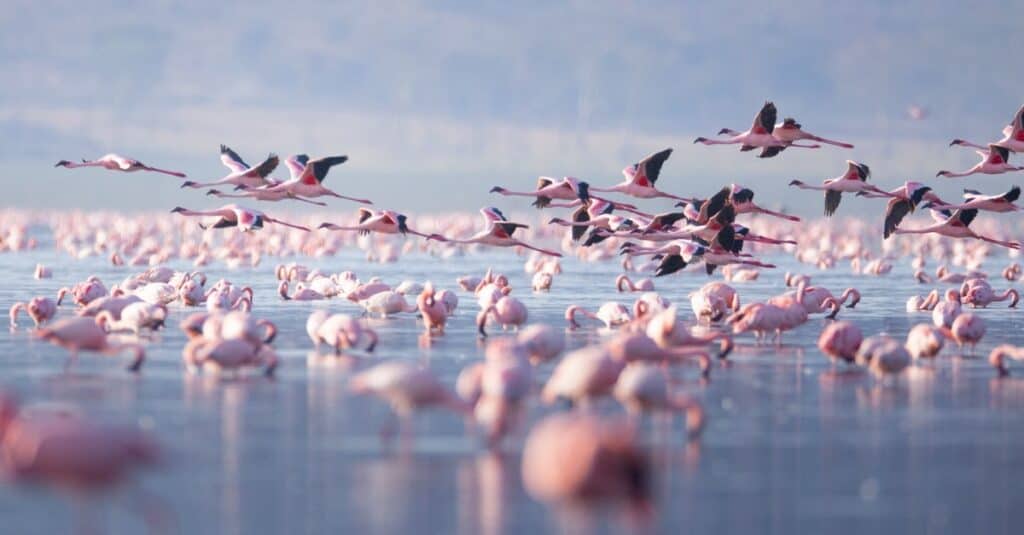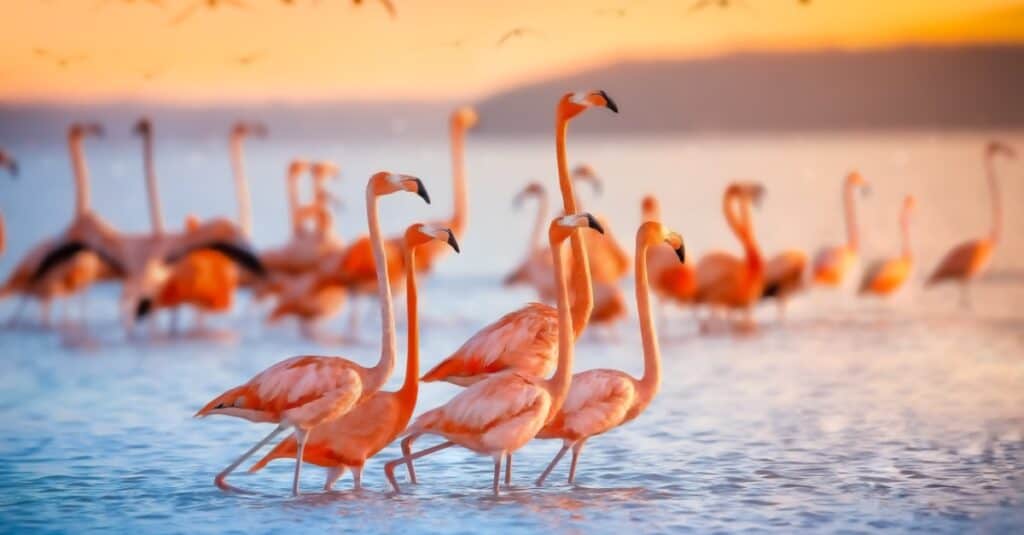Can flamingos fly? With their majestic pink feathers, stilt-like legs, and long necks, flamingos are some of the most fascinating birds alive today. But their strange combination of features leads to questions about how they manage to survive in the dangers of their environment — and that’s led some to question whether or not the flamingo can fly. It’s not an insensible assumption.
Ostriches, emus, and cassowary rank among the world’s largest birds — and they also share an inability to fly. That’s not to say that large birds are always incapable of flight. The wandering albatross has an impressive wingspan of nearly 12 feet and can weigh 16 pounds. Despite that, they can travel over 10,000 miles without ever touching land.
The facts behind why some birds lose the ability to fly are complex, and birds don’t need to be especially large to be flightless. The kiwi bird is only about a foot and a half long, and rails are an entire family consisting of dozens of flightless bird species.
The low number of mammalian predators combined with the high energy expenditure involved in flight led these remote island species to evolve in isolation. If you’ve ever wanted to know how high can a flamingo fly? Can flamingos fly? How far can a flamingo fly? How long can a flamingo fly? Here are the facts — along with the evolutionary context for why their capacity for flight developed in the way it did.
Can Flamingos Fly?

©iStock.com/mantaphoto
Being capable of flight can mean a lot of things to a lot of different birds — and how far, how high, and how long they remain in the air is critical to understanding them.
With their heavy bodies and strong legs, peacocks essentially use flight to give their jumps a little extra lift and roost in tree branches. By contrast, the swift spends an average of 10 months out of every year in flight.
Flamingos fall somewhere in between the two. They’re capable of high altitude and long-distance flight, though they can’t come close to matching how long a swift can fly. And like the peacock, their capacity for flight is situational rather than a primary method of navigation.
Nor do flamingos use their wings to hunt and capture prey, meaning that they don’t need to constantly flap their wings to fly. These are soaring birds that allow wind currents and the aerodynamics of their wing anatomy to do much of the work.
But launching into flight requires quite a bit of momentum, and that’s where the lanky legs of the flamingo prove beneficial. Whether they’re on land or wading in the water, a flamingo will begin takeoff by running at full speed and rapidly flapping their wings.
A greater flamingo can weigh up to nine pounds, but it has some serious assistance thanks to a wingspan that can reach six feet. When taking off, flamingos will stick their heads forward and continue to both flap their wings and pedal their legs until they stabilize.
Landing is similar to a plane touching down. These birds will begin to slow themselves as they drop in altitude and then extend their legs vertically like landing gear as they begin to approach ground level. Touchdown will take the form of a few long strides on the water or land before slowing to a stop.
While in the air, the flamingo settles into a soaring pattern to conserve their energy. To maximize their aerodynamic efficiency, they extend their legs horizontally behind them and stretch their heads forward as far as possible. These birds still look strange in the air, but they don’t look awkward. They’re effective long-distance fliers that can reach speeds of up to 37 miles per hour. How high flamingos fly is one reason you may have never spotted one.
Their typical flight range of 10,000 to 13,000 feet puts them out of range of the visible eye, but flamingo flight patterns appear regularly on the radar. Flying at these altitudes allows flamingos to expend less energy in flight and may also serve as a method for avoiding detection by bird predators.
Flamingo nests are made out of mud and Flamingos actually get their pink hue from the foods that they eat. An interesting fact about them is that they are filter feeders which means that their heads turn up-side down while feasting. Additionally, a group of Flamingos is called a flamboyance.
When and Why Do Flamingos Fly?
The most simple explanation for why flamingos don’t fly more is that their situation doesn’t demand it. This is common among specialist species, which have developed feeding habits that are highly reliant on their specific environment. This can be seen in giant panda bears developing a diet that almost exclusively consists of bamboo and black-footed ferrets facing extinction thanks to the loss of prairie dogs they rely on for food (and the prairie dog burrows they rely on for shelter). For flamingos, it’s brine shrimp.
The algae this shrimp eats produces a chemical called carotenoid which turns their feathers pink. And while that bright coloring makes them more visible to predators, their long legs allow them to wade in deeper waters where threats like lions and packs of hyenas can’t stalk and pursue them effectively. In some instances, these wading birds have developed extreme adaptations to wade in peace.
Lake Natron in Tanzania has water that’s toxic enough to strip away the skin, but the local flamingos have developed incredibly durable legs allowing them to stand in it safely for indefinite periods.
Thanks to those specialized conditions, most flamingos are more likely to walk or swim — which they’re rather capable of — than to fly. In their day-to-day life, flamingos might use short-term flight to retreat to the water when attacked or to travel short distances to another feeding site. But there are usually safe waters that are plentiful with food, and so flamingos tend to gather into sedentary colonies.
Short-distance relocations aren’t uncommon, especially in areas with regular drought or flooding. Flamingo colonies will seek out new territory and regather together.
Long-distance migration isn’t the standard for flamingos, but some habitats necessitate seasonal migration. This is especially true of Andean flamingos which live at elevations above 10,000 feet and have to adjust to the fact that their lake habitats freeze over in the winter. When flamingos do migrate long distances, they usually do so in a flock consisting of their colony.
Flamingos will typically pick clear nights to fly and are known to favor those with strong tailwinds to minimize their workload. When in a flock, these birds will fly at speeds of roughly 30 to 40 MPH. If forced to fly during the day, flamingos will do so at a higher elevation to prevent predators. An Andean flamingo can fly up to 700 miles in a single day, but they’re more likely to cover a distance roughly half that.
Do All Flamingo Species Fly?
All flamingo species can fly, and how far and how often they fly is more contingent on their environment than their species. Some of the most common species known to migrate are the aforementioned Andean flamingo and a population of greater flamingo that seasonally move from their home in southern France to Tunisia and Turkey.
Members of both the greater and lesser flamingo species fly to western India. Mumbai in particular began to see migrations in the early 1980s, but flamingos have been arriving in constantly greater numbers over the past few years.
At What Age Can Flamingos Fly?

©iStock.com/Jonathan Ross
Flamingo chicks are born with gray or white feathers, and they don’t begin to develop their flying feathers until around the age of 11 weeks. Even at that point, flying doesn’t necessarily come naturally — and their wings won’t be developed enough for truly competent flight.
To put the facts into perspective regarding the importance of different survival skills, flamingo chicks will have already left their nest and begun foraging for food with groups of other chicks by the time that they’re three weeks old. Once they’ve started to learn the fundamentals, it will still take a flamingo chick a couple more weeks to be able to properly fly.
Why Don’t Flamingos in Captivity Fly Away?
Flamingos have been kept in zoos for decades, although our understanding of how we ensure they don’t fly away is still evolving — and often a point of contention and debate among animal welfare advocates. The act of trimming feathers is often used, though it’s a process that needs to be repeated and thus is relatively labor-intensive.
Traditionally, many zoos and exhibits will perform a surgery called pinioning on the bird. This process removes the joint on the farthest end of the bird’s wing — and while it prevents flight, it can also throw off their sense of balance and interfere with both courtship rituals and the breeding process itself.
The debate remains on when and how to keep these birds in captivity, and some zoos are experimenting with more natural solutions to displaying flamingos.
Tracy Aviary in Salt Lake City, the San Antonio Zoo, and the Edinburgh Zoo have all held flamingos that haven’t been pinioned in habitats of varying accessibility at different points.
Next Up…
- 10 Incredible Flamingo Facts – Learn some amazing facts you didn’t know about flamingos!
- Can Flamingos Fly? – Learn if flamingos fly and everything else you need to know!
- Flamingo Poop: Everything You’ve Ever Wanted to Know – Let’s talk about poop, keep reading to learn more!
The photo featured at the top of this post is © iStock.com/williamhc
Thank you for reading! Have some feedback for us? Contact the AZ Animals editorial team.






